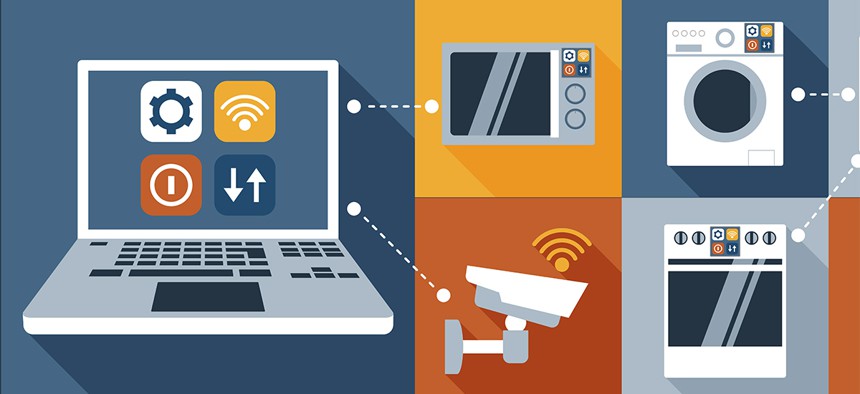You’ve Heard of the Internet of Things. Here’s What Comes Next.

Macrovector/Shutterstock.com
The industrial revolution is coming to the Internet of Things, and it has the potential to really change the world.
John Breeden II is an award-winning journalist and reviewer with over 20 years of experience covering technology and government. He is currently the CEO of the Tech Writers Bureau, a group that creates technological thought leadership content for organizations of all sizes. Twitter: @LabGuys.
Everyone is talking about the Internet of Things these days. And why not? Gartner predicts that those tiny little intelligent sensors embedded into everything from toasters to doorframes to cars and sneakers will grow into a community of 21 billion devices by 2020.
All those sensors constantly recording things, sending their data somewhere, and at times talking with one another is about as Orwellian a future as we are likely to get. Even I am guilty of ogling the IoT like a caveman contemplating fire. As recently as last December in my yearly Nextgov wrap-up column, I predicted IoT would make great strides and start to change the world this year.
But you see, I was wrong about that. Or at least I was only partially right.
The problem with IoT in its raw form is that the sensors don’t really do anything on their own. Having a billion sensors recording one or two variables and reporting those results into an unmonitored system or some massive database probably won’t change anything.
Even the most useful examples of IoT are point-to-point systems, like a sensor network recording that a certain floor of a building is warmer than the others and signaling the HVAC unit to crank up the cooling. It’s useful, but it could be so much more.
And it might be one day soon, once people begin to work more on the relatively new phenomenon that is the Industrial Internet of Things. The IIoT is called that because it has gotten its start in manufacturing, though the technology is beginning to catch on everywhere else now.
Basically, IIoT adds intelligence to the network of sensors that make up IoT. In a way, it’s what IoT was supposed to become when it was first conceived. Instead of just a network of sensors, adding an intelligence layer lets the machines plan and take actions, spot trends and correct mistakes much faster than teams of humans ever could.
In a typical IIoT configuration, the sensors all report into a database. But then big data technology is applied to that raw data, with the goal of identifying trends, problems or even just clues for higher efficiency.
Once a possible inefficiency is identified, machine-to-machine communication allows the devices to make changes without human intervention. The sensors then continue to monitor the new processes while the intelligent part of the network decides if the change had any unintended effect, needs further tweaking or is perfect. These changes can be done at machine speed, so you might have assembly lines self-adjusting themselves constantly in an effort to maintain maximum efficiency.
And machines can be adjusted based on almost any factor, even ones that don’t make a lot of sense at first glance. Perhaps a machine needs to run faster on certain days, or certain times, or based on historical weather patterns. Perhaps slowing down one machine might make others somehow faster. It’s all data to the program doing the analysis.
How effective an IIoT system is depends on several factors including how robust the network of sensors is, how well the big data technology is applied and how efficiently the machines can be controlled automatically from the heart of the network. To some extent, how comfortable an organization is with having humans out of the loop is also a factor.
Everything an IIoT system discovers and does could be done by people if they were willing to stay up every night and pour over the sensor data. But even forcing a human to approve changes can slow efficiency by thousands of percent, so it might be best to keep them in a monitoring role, if anything at all.
IIoT won’t remain the secret weapon of manufacturing for long. Consulting firm Accenture Technology predicts IIoT will soon be breaking out into every sector, primarily helping at first by creating new hybrid business models, using the technology to drive innovation and transforming the landscape of the traditional workforce.
It will be interesting to see if we are still going to call it the Industrial Internet of Things once it begins operating outside of industrial applications. In any case, the industrial revolution is coming to the Internet of Things, and it has the potential to really change the world.
NEXT STORY: Internet in Space Is About as Slow as Dial-Up






